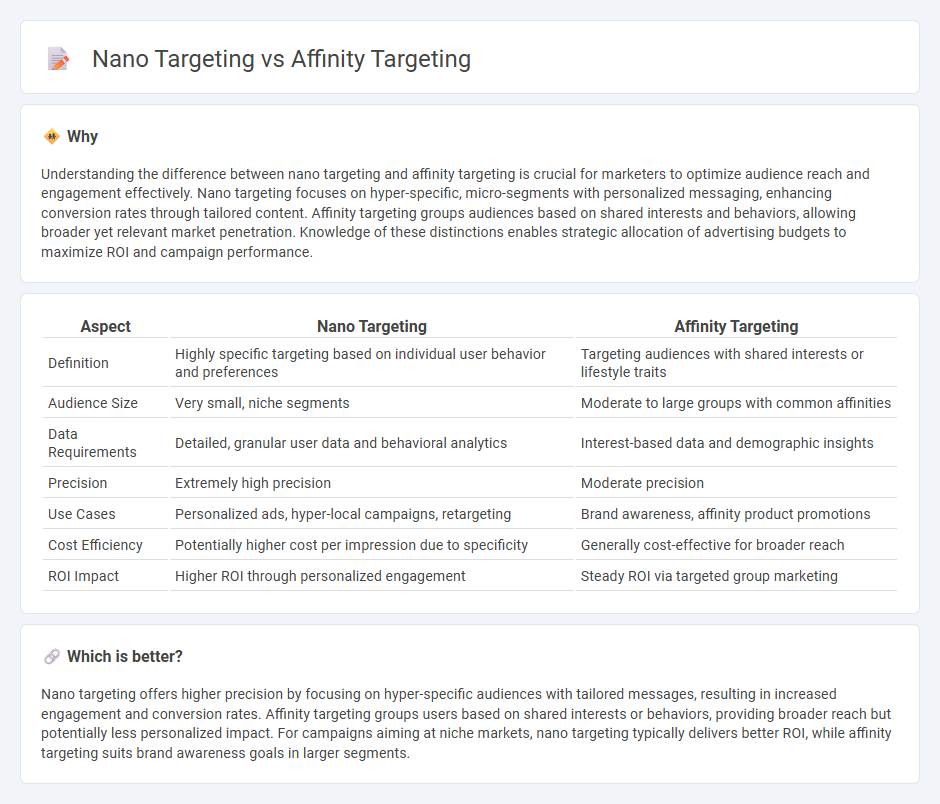
Nano targeting focuses on engaging ultra-specific audience segments by leveraging detailed personal data and behaviors, resulting in highly personalized marketing messages. Affinity targeting identifies broader groups based on shared interests and lifestyles to deliver relevant content that resonates with these collective preferences. Discover how choosing between nano targeting and affinity targeting can transform your marketing strategy.
Why it is important
Understanding the difference between nano targeting and affinity targeting is crucial for marketers to optimize audience reach and engagement effectively. Nano targeting focuses on hyper-specific, micro-segments with personalized messaging, enhancing conversion rates through tailored content. Affinity targeting groups audiences based on shared interests and behaviors, allowing broader yet relevant market penetration. Knowledge of these distinctions enables strategic allocation of advertising budgets to maximize ROI and campaign performance.
Comparison Table
| Aspect | Nano Targeting | Affinity Targeting |
|---|---|---|
| Definition | Highly specific targeting based on individual user behavior and preferences | Targeting audiences with shared interests or lifestyle traits |
| Audience Size | Very small, niche segments | Moderate to large groups with common affinities |
| Data Requirements | Detailed, granular user data and behavioral analytics | Interest-based data and demographic insights |
| Precision | Extremely high precision | Moderate precision |
| Use Cases | Personalized ads, hyper-local campaigns, retargeting | Brand awareness, affinity product promotions |
| Cost Efficiency | Potentially higher cost per impression due to specificity | Generally cost-effective for broader reach |
| ROI Impact | Higher ROI through personalized engagement | Steady ROI via targeted group marketing |
Which is better?
Nano targeting offers higher precision by focusing on hyper-specific audiences with tailored messages, resulting in increased engagement and conversion rates. Affinity targeting groups users based on shared interests or behaviors, providing broader reach but potentially less personalized impact. For campaigns aiming at niche markets, nano targeting typically delivers better ROI, while affinity targeting suits brand awareness goals in larger segments.
Connection
Nano targeting and affinity targeting both enhance marketing precision by leveraging detailed consumer data and behavioral patterns. Nano targeting focuses on hyper-localized, individual-level segmentation, while affinity targeting groups audiences based on shared interests and preferences identified through digital interactions. Their connection lies in enabling marketers to deliver highly personalized and relevant content, maximizing engagement and conversion rates.
Key Terms
Audience Segmentation
Affinity targeting segments audiences based on long-term interests, behaviors, and lifestyle patterns, leveraging data from social media interactions and content consumption to create broad, relevant groups. Nano targeting, by contrast, hones in on hyper-specific audience segments using granular data points like individual preferences, micro-moments, and real-time behavioral signals to deliver highly personalized ads. Explore the nuances and efficacy of these audience segmentation strategies to optimize your marketing approach.
Personalization
Affinity targeting leverages audience interests and behaviors to create broad personalized segments, enhancing ad relevance across digital platforms. Nano targeting, however, hones in on micro-segments using hyper-specific data, providing ultra-personalized content tailored to individual preferences. Explore how mastering these strategies can elevate your personalization efforts and marketing ROI.
Relevance
Affinity targeting focuses on broad audience segments based on interests and behaviors, delivering relevant ads to groups sharing similar characteristics. Nano targeting narrows this further by leveraging granular data to reach individuals with highly specific preferences and intent signals, maximizing ad relevance and engagement. Explore how advanced targeting techniques can elevate your marketing strategy for deeper consumer connections.
Source and External Links
Ultimate Guide to Understanding In-Market vs. Affinity Audiences - This guide explains the difference between affinity and in-market audiences, focusing on how affinity audiences are built around shared interests and hobbies.
Affinity audiences targeting - Display & Video 360 Help - This resource provides information on how affinity audiences can be used to raise awareness among groups with strong interests in specific products or services.
What Are Affinity Audiences, and How Do You Target Them? - This article discusses how affinity audiences are created based on analyzing users' long-term activities to target advertising campaigns more effectively.
 dowidth.com
dowidth.com